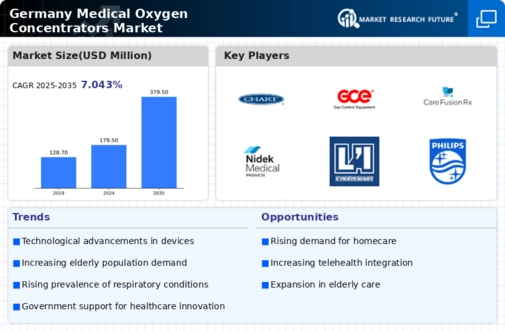Regulatory Support for Medical Devices
Regulatory support for medical devices in Germany is a significant driver for the medical oxygen-concentrators market. The German government has established a robust regulatory framework that facilitates the approval and commercialization of medical devices, including oxygen concentrators. This supportive environment encourages manufacturers to invest in research and development, leading to the introduction of innovative products in the market. Additionally, the European Union's Medical Device Regulation (MDR) provides a clear pathway for compliance, ensuring that devices meet safety and efficacy standards. As a result, the medical oxygen-concentrators market is likely to experience growth, as manufacturers are motivated to bring new and improved products to market. The combination of regulatory support and a focus on quality assurance is expected to enhance consumer confidence, further driving demand for medical oxygen concentrators.
Rising Prevalence of Respiratory Disorders
The increasing incidence of respiratory disorders in Germany is a primary driver for the medical oxygen-concentrators market. Conditions such as chronic obstructive pulmonary disease (COPD) and asthma are becoming more prevalent, affecting a significant portion of the population. According to health statistics, approximately 6.8 million individuals in Germany suffer from COPD, which necessitates the use of oxygen therapy. This growing patient base is likely to propel demand for medical oxygen-concentrators, as healthcare providers seek effective solutions to manage these chronic conditions. Furthermore, the aging population, which is more susceptible to respiratory ailments, is expected to contribute to market growth. As a result, the medical oxygen-concentrators market is poised for expansion, driven by the need for reliable oxygen delivery systems to support patients with respiratory challenges.
Growing Awareness of Home Healthcare Solutions
The rising awareness of home healthcare solutions in Germany is driving the medical oxygen-concentrators market. Patients and caregivers are increasingly recognizing the benefits of receiving medical care at home, which includes enhanced comfort and convenience. This trend is particularly relevant for individuals with chronic respiratory conditions who require continuous oxygen therapy. The medical oxygen-concentrators market is likely to see a surge in demand as more patients opt for home-based treatment options. According to recent surveys, approximately 70% of patients prefer home healthcare over traditional hospital stays. This indicates a shift in patient preferences. This growing inclination towards home healthcare is expected to stimulate the market, as manufacturers respond by developing portable and user-friendly oxygen concentrators that cater to the needs of patients in home settings.
Increased Investment in Healthcare Infrastructure
Germany's commitment to enhancing its healthcare infrastructure is a significant driver for the medical oxygen-concentrators market. The government has been investing heavily in healthcare facilities, aiming to improve patient care and access to medical technologies. In recent years, healthcare expenditure has risen, with a focus on integrating advanced medical devices into hospitals and clinics. This investment is likely to facilitate the adoption of medical oxygen-concentrators, as healthcare providers seek to equip their facilities with state-of-the-art equipment. Additionally, the push for digital health solutions and telemedicine is expected to create new opportunities for the medical oxygen-concentrators market, as remote monitoring and home care become more prevalent. Consequently, the market is anticipated to benefit from these infrastructural advancements, leading to increased availability and utilization of oxygen concentrators.
Technological Innovations in Oxygen Concentrators
Technological innovations are playing a crucial role in shaping the medical oxygen-concentrators market. Advances in technology have led to the development of more efficient and compact oxygen concentrators, which are easier to use and maintain. Features such as continuous flow settings, pulse dose delivery, and enhanced filtration systems are becoming standard in new models. These innovations not only improve patient outcomes but also increase the appeal of oxygen concentrators among healthcare providers. The market is likely to benefit from the introduction of smart oxygen concentrators equipped with connectivity features, allowing for remote monitoring and data sharing. As technology continues to evolve, the medical oxygen-concentrators market is expected to expand, driven by the demand for high-quality, reliable, and technologically advanced oxygen delivery systems.























Leave a Comment